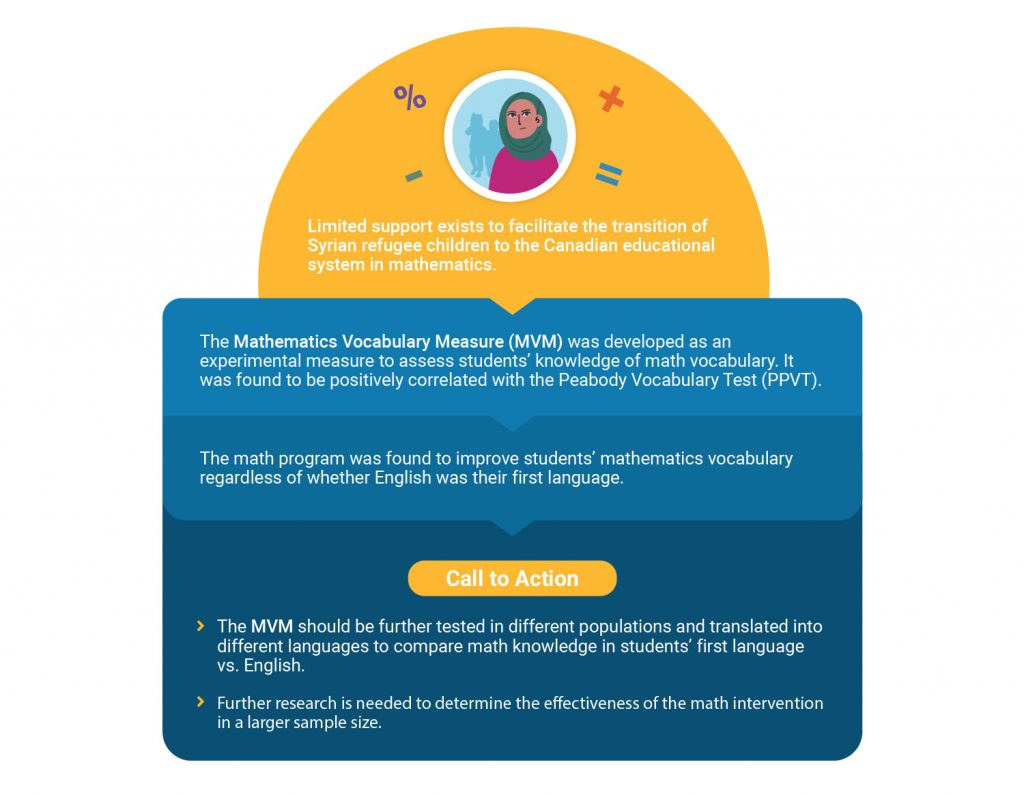A Culturally Sensitive Intervention for Syrian Refugee Children with Interrupted Schooling: Targeting Math Vocabulary and Associated Number Sense Skills
Researchers: Esther Geva and Deborah Benhamu
Affiliation: University of Toronto, OISE
Keywords: Syrian refugee children, school, interrupted schooling, after-school intervention, the Mathematics Vocabulary Measure (MVM), math vocabulary, Math Fluency measure (WIAT), KTEAs
Jump to: Full Infographic, Methodology, Findings, Publications & Reports
Summary
Objective: This study contained three phases aimed at evaluating the effectiveness of a math vocabulary intervention for Syrian refugee children who recently arrived in Canada. The first phase consisted of a pilot intervention to explore the extent to which targeted math vocabulary tutoring in the second language of English could facilitate mathematics learning. Phase two developed a vocabulary measure specific to mathematics, and the third phase implemented the full intervention in a Toronto school that served many refugee and immigrant children.
Justification: Prior to their arrival in Canada, many Syrian refugee children experience significant disruptions and/or limited access to education and trauma related experiences, leading many to fall behind their age appropriate grade level. Limited support exists to facilitate their transition to the Canadian educational system in the area of mathematics. The ability to communicate mathematically is an important component of overall mathematics proficiency and academic development (Riccomini et al., 2015).
Practical goal: This study sought to develop and evaluate an effective intervention for enhancing students’ math vocabulary related to the concepts they were learning, thereby improving their overall math skills.
Primary audience: educators, policy makers, and service providers
Infographic Excerpt

Methodology
In the pilot program, 30 Syrian refugee students in grades 1 to 7 attended bi-weekly sessions over a period of three months. Individualized tutoring was provided by university student tutors; in each session, at least 2 English-Arabic bilingual student teachers were present. The pilot study was a quasi-experimental design, with data collected at pre-test, intervention, and post-test. Students’ mathematical knowledge was assessed using the Math Fluency measure (WIAT) and the KTEA Concepts and Applications subtests.
In Phase Two, the Mathematics Vocabulary Measure (MVM) was developed to more accurately measure students’ knowledge of mathematics academic vocabulary.
In Phase Three, an after-school math vocabulary program was implemented at a school in Toronto serving many immigrant and refugee children. The design was a pretest- intervention-post-test with a wait-listed control group. The sample included 48, third-grade elementary school students; teachers nominated children who they perceived as vulnerable and believed could benefit from the math intervention. Participants were then randomized into immediate and waitlisted control groups at the classroom level. Six classrooms were designated as immediate intervention, and six classrooms were designated as waitlisted control classes who completed the intervention in the second semester. Two students did not complete the intervention and complete data was available for 39 participants; 17 were ESL students and 22 spoke English as their first language.
Findings
In both the pilot study and the full intervention, there were significant increases in math vocabulary following the intervention. When comparing the intervention and waitlisted group, the intervention group improved significantly more than the waitlist group on the Mathematics Vocabulary Measure. In fact, children in the waitlisted group did not improve at all during the semester on their familiarity with math vocabulary. There was also a significant effect of time, such that participants in the intervention increased their knowledge of math academic vocabulary during the entire study. Overall, this study shows that this intervention program can support the development of mathematics vocabulary and the underlying math concepts regardless of the home language.
- A number of teaching resources were developed during the intervention, including a set of lessons plans that are available for teachers to use in their classrooms.
Explore more projects


